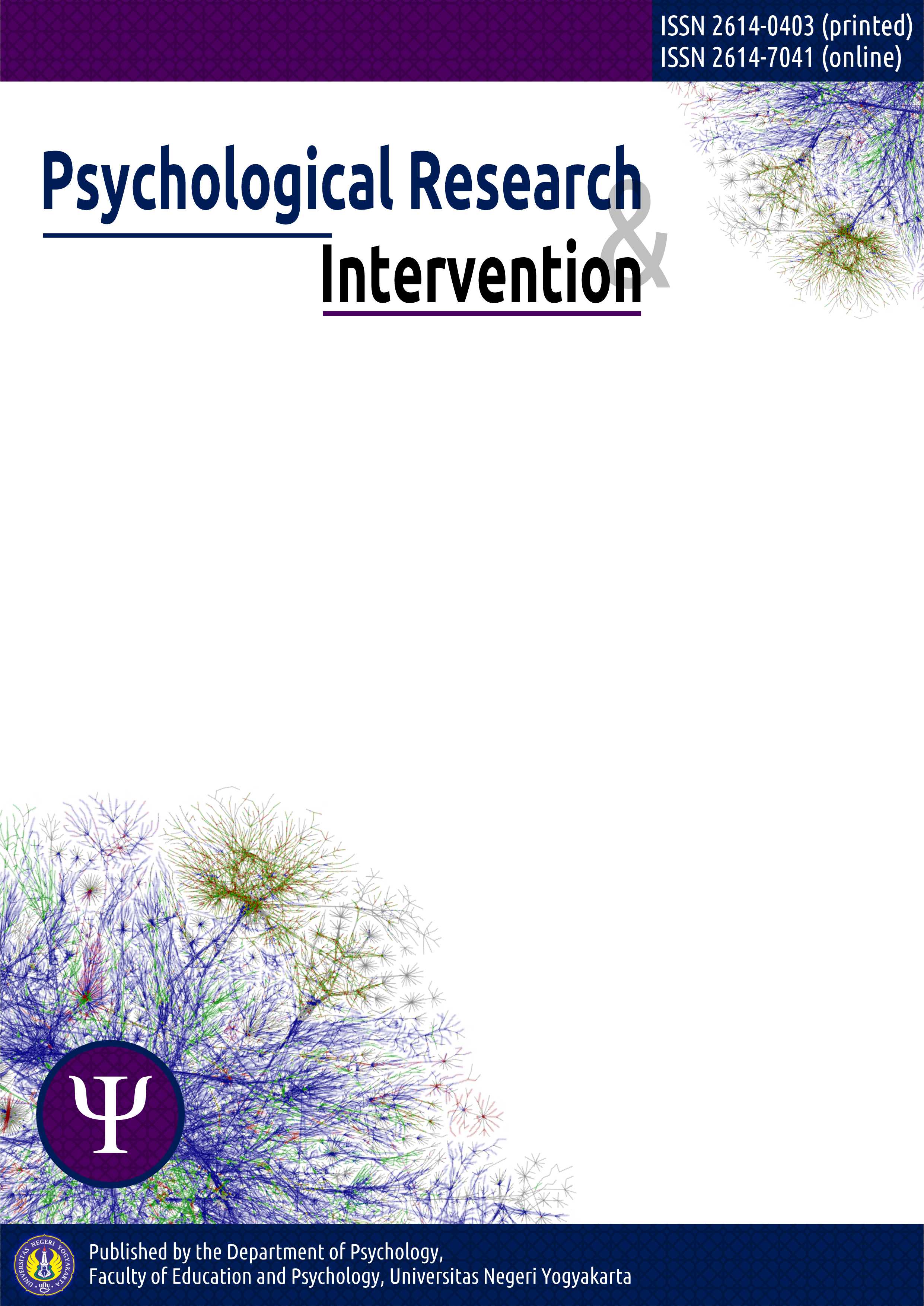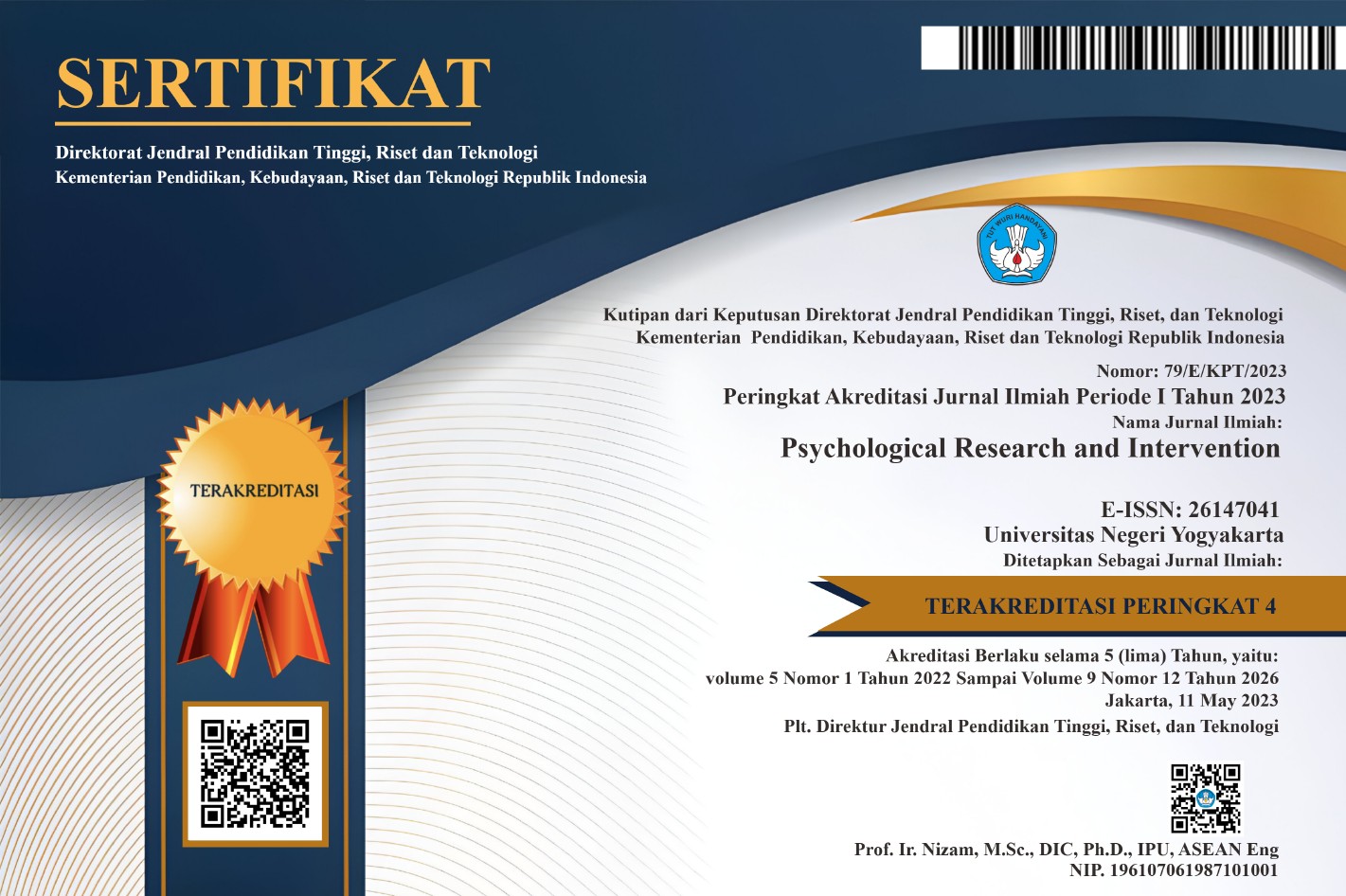Differences in The Level of Loneliness Experienced by Male and Female University Students During The Covid-19 Pandemic
DOI:
https://doi.org/10.21831/pri.v4i2.44900Keywords:
loneliness, covid-19 pandemic, studentAbstract
The implementation of the physical distancing policy as an effort to prevent the transmission of the COVID-19 virus seems to have resulted in loneliness problems for students. Many studies have shown that loneliness is bad for health, such as decreased immunity and cognitive function. By knowing groups vulnerable to loneliness, appropriate preventive and curative measures can be taken. Unfortunately, few studies discuss the differences in the level of loneliness in groups of men and women. This study aims to determine whether there are differences in the level of loneliness in male and female university students during the COVID-19 pandemic. The approach used is quantitative with a comparative design. The total subjects were 192 University students consisting of 148 women (77%) and 44 men (23%). The participants were obtained using an online questionnaire through the accidental purposive sampling method. The research instrument used is the UCLA Loneliness Scale Version 3 Indonesian edition which has an alpha coefficient of 0.92. Data analysis used a different independent sample t-test. The data obtained shows that the average loneliness for men is 38,272 and for women 38,108. Based on the difference test, we obtained the following result t (190) = 0.127, p > 0.05. So it can be concluded that there is no significant difference in loneliness between male and female university students.References
Akbag, M., & Imamoglu, S.E. (2010). The Prediction of Gender and Attachment Styles on Shame, Guilt, and Loneliness. Educational Sciences: Theory & Practice, 10 (2), 669-682. Retrieved from https://eric.ed.gov/?id=EJ889191
Azwar, S. (2019). Metode Penelitian Psikologi Edisi II. Pustaka Pelajar
Bahl, P., Doolan, C., De Silva, C., Chughtai, A. A., Bourouiba, L., & MacIntyre, C. R. (2020). Airborne or droplet precautions for health workers treating COVID-19?. The Journal of infectious diseases. https://doi.org/10.1093/infdis/jiaa189
Banerjee, D., & Rai M. (2020). Social isolation in Covid-19: The impact of loneliness. International Journal of Social Psychiatry, 66(6), 525-527. https://doi.org/10.1177/0020764020922269
Badcock, J. C., Adery, L. H. & Park, S. (2020). Loneliness in psychosis: A practical review and critique for clinicians. Clinical Psychology: Science and Practice, 27(4), pp. 1–13. https://doi.org/10.1111/cpsp.12345.
Barreto, M., Victor, C., Hammond, C., Eccles, A., Richins, M., & Qualter, P. (2020). Loneliness around the world: Age, gender, and cultural differences in loneliness. Personality and Individual Differences. https://doi.org/10.1016/j.paid.2020.110066
Bek, H. (2017). Understanding the Effect of Loneliness on Academic Participation and Success among International University Students. Journal of Education and Practice. 8 (14), 46-50. https://doi.org/10.13054
Cacioppo, J, & Patrick, W. (2008). Loneliness: Human Nature and The Need for Social Connection. W W Norton & Company.
Center for Systems Science and Engineering. (2021, 17 April). COVID-19 Dashboard by the Center for Systems Science and Engineering (CSSE) at Johns Hopkins University. Retrieved from https://gisanddata.maps.arcgis.com/apps/opsdashboard/index.html#/bda7594740fd40299423467b48e9ecf6
Dariyo, A. (2016). Hubungan antara Kesepian dan Motif Persahabatan dengan komunikasi on line pada remaja akhir. Psikodimensia, 15 (2), 236-253. https://doi.org/10.24167/psiko.v15i2.990
Fikrie, L., & Hermina, C. (2019). Perbedaan Kesepian pada Mahasiswa Tahun Pertama dan Kedua. Naskah Prosiding Temilnas XI IPPI.
Given, Lisa M. (2008). The Sage encyclopedia of qualitative research methods. Sage.
Hidayati, D. S. (2015). Self Campassion dan Loneliness. Jurnal ilmiah psikologi terapan 3 (1), 154-164. https://doi.org/10.22219/jipt.v3i1.2136
Kohanski, M. A., Palmer, J. N., & Cohen, N. A. (2020). Aerosol or droplet: critical definitions in the COVID-19 era. International forum of allergy & rhinology, 10(8), 968–969. https://doi.org/10.1002/alr.22591
Loades et al. (2020). Rapid systematic review: The impact of Social Isolation and Loneliness on the Mental Health of Children and Adolescents in the Context of COVID-19. Journal of the American Academy of Child & Adolescent Psychiatry. DOI: https://doi.org/10.1016/j.jaac.2020.05.009.
Mahon, N.E., Yarcheski, A., Yarcheski, T.J., Cannella, B.L., Hanks, M.M. (2006). A Meta-Analytic Study of Predictors for Loneliness During Adolescence. Nursing Research, 55, 5: 308–315
Marmot, M. (2018). The Health Gap: The Challenge of an Unequal World. Bloomsbury
Momtaz, Y. A., Hamid, T. A., Yusoff, S., Ibrahim, R., Chai, S. T., Yahaya, N., & Abdullah, S. S. (2012). Loneliness as a Risk Factor for Hypertension in Later Life. Journal of Aging and Health, 24(4), 696–710. https://doi.org/10.1177/0898264311431305
Neto, F. (2014). Socio-Demographic Predictors of Loneliness across the Adult Life Span in Portugal. An International Journal on Personal Relationships. 8 (2), 222–230. https://doi.org/10.5964/IJPR.V8I2.171
Noor, J. (2011). Metodologi Penelitian: Skripsi, Tesis, Disertasi dan Karya Ilmiah. Kencana
Novidianto, R., & Dani, A. (2020). Analisis Klaster Kasus Kasus Aktif Covid-19 Menurut Provinsi di Indonesia Berdasarkan Data Deret Waktu. Jurnal Aplikasi Statistika & Komputasi Statistik, 12(2), 15-24. https://doi.org/10.34123/jurnalasks.v12i2.280
Nurdiani, A. F. (2014). Uji Validitas Konstruk Alat Ukur UCLA Loneliness Scale Version 3. Jurnal Pengukuran Psikologi dan Pendidikan Indonesia, 3 (4), 377-391. https://doi.org/10.15408/jp3i.v3i4.9322
Nuzuli, A. (2020). Komunikasi Orang Tua dan Tingkat Stres Mahasiswa Perantauan Pada Larangan Mudik Covid 19. KOMUNIDA: Media Komunikasi dan Dakwah, 10(02), 242-260. https://doi.org/10.35905/komunida.v10i02.1525
Papalia, D.E, Olds, S.W & Feldman, R.D. (2011). Human Development. (11th ed.). McGraw-Hill.
Peltzer K, & Pengpid S. (2017) Loneliness and health risk behaviors among ASEAN adolescents. Iran J Psychiatry Behav Sci, 1(3), 13-24. https://doi.org/10.5812/ijpbs.7691.
Rantepadang A. & Gery, A. B. (2020). Hubungan Psychological Well Being dengan Loneliness. Nutrix journal 4 (1), 59-62. https://doi.org/10.37771/nj.Vol4.Iss1.428
Rokach, A. (2018). The Effect of Gender and Culture on Loneliness: A Mini Review. Emerging Science Journal, 2(2), 59-64. https://doi.org/10.28991/esj-2018-01128
Sagita, D. D., & Hermawan, D. (2020). Kesepian Remaja Pada Masa Pandemi COVID-19. ENLIGHTEN: Jurnal Bimbingan Konseling Islam, 3(2), 122-130. https://doi.org/10.32505/enlighten.v3i2.1892
Samsyul, S., Widyastuti, & Nurdin, M, N, H. (2018). Motif Persahabatan dan Kesepian pada Santri. Jurnal Psikologi Talenta, 3 (2), 1-12
Santrock, J.W. (2007). Adolescence. Boston: McGraw-Hill.
Setyorini, I. (2020). Pandemi Covid-19 dan Online Learning: Apakah berpengaruh terhadap proses pembelajaran pada kurikulum 13. Journal of Industrial Engineering & Management Research (JIEMAR) 1 (1), 95-101. https://doi.org/10.7777/jiemar.v1i1
Stickley, A., & Koyanagi, A. (2016). Loneliness, common mental disorders and suicidal behavior: Findings from a general population survey. Journal of Affective Disorders, 197, 81–87. https://doi.org/10.1016/j.jad.2016.02.054
Sugiyono (2013). Metode Penelitian Kuantitatif Kualitatif dan R&D. Alfabeta
Theeke, L., Carpenter, R., Mallow, J., & Theeke, E. (2019). Gender differences in loneliness, anger, depression, self-management ability and biomarkers of chronic illness in chronically ill mid-life adults in Appalachia. Applied Nursing Research, 45, 55–62. https://doi.org /10.1016/j.apnr.2018.12.001
Wilson et al. (2007). Loneliness and risk of Alzheimer disease. Archives of General Psychiatry, 64(2), 234–240. https://doi.org/10.1001/archpsyc.64.2.234












